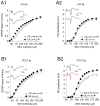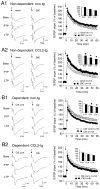Altered hippocampal synaptic function in transgenic mice with increased astrocyte expression of CCL2 after withdrawal from chronic alcohol
- PMID: 29499275
- PMCID: PMC5975123
- DOI: 10.1016/j.neuropharm.2018.02.031
Altered hippocampal synaptic function in transgenic mice with increased astrocyte expression of CCL2 after withdrawal from chronic alcohol
Abstract
CNS actions of the chemokine CCL2 are thought to play a role in a variety of conditions that can have detrimental consequences to CNS function, including alcohol use disorders. We used transgenic mice that express elevated levels of CCL2 in the CNS (CCL2-tg) and their non-transgenic (non-tg) littermate control mice to investigate long-term consequences of CCL2/alcohol/withdrawal interactions on hippocampal synaptic function, including excitatory synaptic transmission, somatic excitability, and synaptic plasticity. Two alcohol exposure paradigms were tested, a two-bottle choice alcohol (ethanol) drinking protocol (2BC drinking) and a chronic intermittent alcohol (ethanol) (CIE/2BC) protocol. Electrophysiological measurements of hippocampal function were made ex vivo, starting ∼0.6 months after termination of alcohol exposure. Both alcohol exposure/withdrawal paradigms resulted in CCL2-dependent interactions that altered the effects of alcohol on synaptic function. The synaptic alterations differed for the two alcohol exposure paradigms. The 2BC drinking/withdrawal treatment had no apparent long-term consequences on synaptic responses and long-term potentiation (LTP) in hippocampal slices from non-tg mice, whereas synaptic transmission was reduced but LTP was enhanced in hippocampal slices from CCL2-tg mice. In contrast, the CIE/2BC/withdrawal treatment enhanced synaptic transmission but reduced LTP in the non-tg hippocampus, whereas there were no apparent long-term consequences to synaptic transmission and LTP in hippocampus from CCL2-tg mice, although somatic excitability was enhanced. These results support the idea that alcohol-induced CCL2 production can modulate the effects of alcohol exposure/withdrawal on synaptic function and indicate that CCL2/alcohol interactions can vary depending on the alcohol exposure/withdrawal protocol used.
Keywords: Chronic intermittent alcohol exposure; Hippocampus; Memory and learning; Synaptic plasticity; Synaptic transmission; Two-bottle choice alcohol drinking.
Copyright © 2018 Elsevier Ltd. All rights reserved.
Conflict of interest statement
The authors have no conflict of interest to declare.
Figures





Similar articles
-
Altered hippocampal synaptic transmission in transgenic mice with astrocyte-targeted enhanced CCL2 expression.Brain Behav Immun. 2011 Jun;25 Suppl 1(0 1):S106-19. doi: 10.1016/j.bbi.2011.02.013. Epub 2011 Feb 26. Brain Behav Immun. 2011. PMID: 21356306 Free PMC article.
-
Synaptic plasticity in the hippocampus shows resistance to acute ethanol exposure in transgenic mice with astrocyte-targeted enhanced CCL2 expression.Neuropharmacology. 2013 Apr;67:115-25. doi: 10.1016/j.neuropharm.2012.11.007. Epub 2012 Nov 16. Neuropharmacology. 2013. PMID: 23164616 Free PMC article.
-
Transgenic mice with increased astrocyte expression of IL-6 show altered effects of acute ethanol on synaptic function.Neuropharmacology. 2016 Apr;103:27-43. doi: 10.1016/j.neuropharm.2015.12.015. Epub 2015 Dec 17. Neuropharmacology. 2016. PMID: 26707655 Free PMC article.
-
Regulation of hippocampal synaptic plasticity by cyclic AMP-dependent protein kinases.Prog Neurobiol. 2003 Dec;71(6):401-37. doi: 10.1016/j.pneurobio.2003.12.003. Prog Neurobiol. 2003. PMID: 15013227 Review.
-
Neurochemical basis of disruption of hippocampal long term potentiation by chronic alcohol exposure.Front Biosci. 1997 Jun 15;2:d309-16. doi: 10.2741/a193. Front Biosci. 1997. PMID: 9206984 Review.
Cited by
-
Review of cocaine-induced brain vascular and cellular function changes measured in vivo with optical imaging.Neurophotonics. 2025 Jan;12(Suppl 1):S14611. doi: 10.1117/1.NPh.12.S1.S14611. Epub 2025 May 28. Neurophotonics. 2025. PMID: 40438148 Free PMC article. Review.
-
Neuroimmune interactions with binge alcohol drinking in the cerebellum of IL-6 transgenic mice.Neuropharmacology. 2023 May 1;228:109455. doi: 10.1016/j.neuropharm.2023.109455. Epub 2023 Feb 10. Neuropharmacology. 2023. PMID: 36775097 Free PMC article.
-
Research Needs for Inpatient Management of Severe Alcohol Withdrawal Syndrome: An Official American Thoracic Society Research Statement.Am J Respir Crit Care Med. 2021 Oct 1;204(7):e61-e87. doi: 10.1164/rccm.202108-1845ST. Am J Respir Crit Care Med. 2021. PMID: 34609257 Free PMC article.
-
Neuroimmune signaling in alcohol use disorder.Pharmacol Biochem Behav. 2019 Feb;177:34-60. doi: 10.1016/j.pbb.2018.12.007. Epub 2018 Dec 24. Pharmacol Biochem Behav. 2019. PMID: 30590091 Free PMC article. Review.
-
Astrocytes modulate cerebral blood flow and neuronal response to cocaine in prefrontal cortex.Mol Psychiatry. 2024 Mar;29(3):820-834. doi: 10.1038/s41380-023-02373-9. Epub 2024 Jan 19. Mol Psychiatry. 2024. PMID: 38238549 Free PMC article.
References
-
- Banisadr G, Gosselin RD, Mechighel P, Rostene W, Kitabgi P, Melik Parsadaniantz S. Constitutive neuronal expression of CCR2 chemokine receptor and its colocalization with neurotransmitters in normal rat brain: functional effect of MCP-1/CCL2 on calcium mobilization in primary cultured neurons. J Comp Neurol. 2005;492:178–192. - PubMed
-
- Baxter-Potter LN, Henricks AM, Berger AL, Bieniasz KV, Lugo JM, McLaughlin RJ. Alcohol vapor exposure differentially impacts mesocorticolimbic cytokine expression in a sex-, region-, and duration-specific manner. Neuroscience. 2017;346:238–246. - PubMed
-
- Becker HC, Lopez MF. Increased ethanol drinking after repeated chronic ethanol exposure and withdrawal experience in C57BL/6 mice. Alcohol Clin Exp Res. 2004;28:1829–1838. - PubMed
Publication types
MeSH terms
Substances
Grants and funding
LinkOut - more resources
Full Text Sources
Other Literature Sources
Medical
Miscellaneous

